Top News

February 15, 2021 Ryukyu Shimpo
By Takahiro Kina
Okinawa – On January 23, a basket weaving workshop using shell ginger for material was held at Go-ma House, a multipurpose space in Nakasone in Okinawa City.
The instructor was Yuko Chibana, a farmer who manages Nakatager Vegega farm in Urasoe. She made the basket materials by spreading out shell ginger stalks and drying them for approximately one month. While there are many baskets made from fountain palms or pandanus in Okinawa, there are no baskets made from shell ginger, and so Chibana taught herself to make them by referring to Taiwanese handicrafts.
Chibana also uses string made from shell ginger to tie muchi. She says, “Shell ginger is very common and I planned the workshop in hopes that people would realize its value. I want to propose a way to reduce plastic use by using shell ginger, which breaks down naturally, to make daily necessities.”
Yasuno Matayoshi of Uruma says, “I was surprised that we can make baskets from natural materials. Plus, the finished product was unique for everyone, which was wonderful.”
(English translation by T&CT and Ellen Huntley)
Go to Japanese

February 18. 2021 Ryukyu Shimpo
February 18 falls on Usui, one of the 24 solar terms of the lunisolar calendar. It is known as the time of the year when warm weather begins to melt the snow away, and farmers prepare to work as plant life begins to bud. Nonetheless, cold air enveloped the Okinawa region on February 17.
In the fields of Kyan, Itoman City, carrots—the town’s specialty vegetable, reached peak harvest. Isao Fujita, 46, harvested the crop under the frigid air, bundled up in cold-weather gear. He said with a smile, “This season, the [carrots’] shape and size turned out nicely.”
(English translation by T&CT and Monica Shingaki)
Go to Japanese
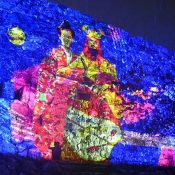
February 17, 2021 Ryukyu Shimpo
Nakijin – the Nakijin Tourism Association implemented a projection mapping at Nakijin Castle remains on February 13 and 14. Images like Taiwan cherry blossoms and the ancient Hokuzan king were vividly projected against the castle wall of the world heritage site.
In normal years, visitors can visit the castle and surrounding areas to see the blossoming cherry trees, and the area is lit up for a cherry blossom festival. This year however, the festival was cancelled due to the ongoing COVID-19 pandemic, and so instead they moved forward with just the distinct light-up. The projection mapping is a first-time trial run. The projection was put up for village residents on January 30, then done so again for the general public on February 13 and 14.
The projection mapping projected images of the Hokuzan king and queen and of the castle itself at around a 3-minute interval across the width and height of the castle’s Heiro gate. A woman in her fifties who was visiting from Nago said “The light-up display was very pretty.”
(English translation by T&CT and Sam Grieb)
Go to Japanese
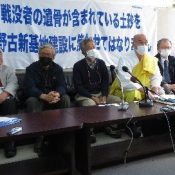
February 16, 2021 Ryukyu Shimpo
Takamatsu Gushiken, representing Gamafuya, a volunteer organization that collects the remains of those who died in the Battle of Okinawa, along with the “Association of Religious Leaders Calling for Peace,” held a press conference at the Okinawa Prefectural Office Press Club February 15. The groups are demanding a stop to a plan to harvest dirt from the southern region of Okinawa’s main island for use in the land reclamation effort, which is part of the new military base construction in Nago’s Henoko neighborhood, calling it “government violence.” They also indicated a necessity for governor Denny Tamaki to inspect the site of the dirt collection.
According to a construction design change proposal submitted to Okinawa Prefecture by the Okinawa Defense Bureau (ODB), the plan is to procure around 32 million cubic meters of dirt from Itoman and Yaese, around 70% of the potential amount of dirt collected in Okinawa. It was noted that the southern region of Okinawa contains Okinawa Senseki Quasi-National Park, and that under the Natural Parks Law environmental exploitation is restricted. In Itoman’s Komesu neighborhood, contractors began in harvesting dirt without submitting a notification stipulated in the Natural Parks Law. At the instruction of Okinawa Prefecture, a notification was finally submitted in January of this year.
Prior to the press conference, the religious leaders met with representatives from the relevant prefectural departments. They demanded that dirt harvesting be stopped so that the collection of war dead remains could be started, and to prevent the environmental damage caused by the construction. They also demanded that the governor make use of an article in the Natural Parks Law that allowed him to ban environmental exploitation in order to protect the landscape. Zenji Shimada, a pastor at a church in Ginowan and leader of the plaintiff group that sued the government to stop the noise pollution at Futenma, criticized the plan, “I cannot stand for this ground to be used for a military base.”
Gushiken visited the Itosu Trench in Ishiski, Itoman with the religious leaders on February 14. He noted the fingers, bones, and teeth of children in front of the trench, explaining, “The collection of war dead remains has no end.” In order for Gushiken to show his intention to oppose the collection of dirt from the southern region, he plans on carrying out a hunger strike nearby. At the press conference on February 15, he said, “To use the ground filled with the blood of those killed in battle in land reclamation [for a military base] is a mistake on a humanitarian level. I believe that the remains are calling for us to help them.”
Also in attendance at the press conference was Atsushi Kitaueda from the Okinawa Citizens for Peace Liaison Council, who said, “In the southern region, you see 20, 30-meter holes from mining that were never refilled, and left in an awful state. It is clear that Komesu will also have its landscape destroyed down to its foundation.”
(English translation by T&CT and Sam Grieb)
Go to Japanese
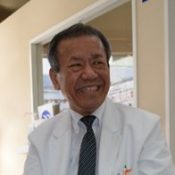
February 16, 2021 Ryukyu Shimpo
Hajime Sunagawa, an advisor for the Okinawa-Laos Cleft Lip and Palate Support Center, which helps provide treatment to cleft lip and palate patients in Laos, recently received the 22nd Nishi-Nippon International Foundation Asia Contribution Award. The Foundation honors organizations and individuals in the Kyushu, Okinawa, and Yamaguchi regions that contribute to international exchange in Asia.
Sunagawa began his work in 2001 out of the Setthathirath Hospital in Laos, and by 2019 he had provided free surgery and treatment to 347 cleft lip and cleft palate patients. In receiving the award, Sunagawa thanked everyone involved and said, “We were able to continue the project thanks to the cooperation of the Japan Cleft Palate Association and the University of the Ryukyus Hospital staff.”
He plans to continue his work while assessing safety levels during the novel coronavirus pandemic. The award ceremony will be held in Fukuoka City on March 2.
(English translation by T&CT and Monica Shingaki)
Go to Japanese
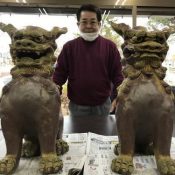
February 12, 2021 Ryukyu Shimpo
By Ryota Nakamura
Next month, March 11, will mark the 10-year anniversary of the 2011 Tohoku earthquake. Izena native Yukiteru Naka, 79, chairman of Tohoku Enterprise, which is tasked with nuclear power plant maintenance, is building an observation deck overlooking the ocean in front of his house in Tomioka, Fukushima. Carved in memory of the earthquake, and praying that another disaster does not occur, are two Tsuboya ceramic Shisa that will be placed on the observation deck. “Since I was working in nuclear power, I feel like both a perpetrator and a victim. I felt that there must be something that I could do for the area.” While dealing with these complex emotions, he continues to think of the land where he lives.
The observation deck will be made of wood and will have two levels, and will be built at a high elevation overlooking the Pacific Ocean. The Shisa, which ward off misfortune, were made by the late “contemporary master craftsman” Ikuo Takaesu around 40 years ago. As a native of Izena and through personal connections, the studio sold the Shisa for a low price “for the restoration [of Fukushima] with Shisa that are packed with soul.” They have also decided to offer Okinawa roofing tiles to Okinawa for Shuri Castle, which was destroyed in a fire, and plan on laying down the dirt floor.
Naka was at his office in Tomioka when the earthquake hit March 11, 2011. When the accident at the Tokyo Electric Power Company’s (Tepco) Fukushima Daiichi Nuclear Power Plant happened, a 20 km radius around the plant became a hazard area. Naka and other company employees photographed the town’s landscape, and recorded the stories of victims in a collection they published titled, “3/11 – We cannot forget – stories of the earthquake.”
It has been 10 years since then. People’s lives were upheaved, and the town’s landscape was forever transformed. Tomioka’s residency restrictions were lifted in April of 2017, however the population of the town at the end of January was only 12,319 people, with only 1,576 people actually living there; only around 1/10 of the population before the earthquake.
“Many people are not going to return; however, the observation deck is located along a seaside walking course near the rebuilt houses,” says Naka. He is looking forward to seeing the guardian deities keeping watch over the ocean.
(English translation by T&CT and Sam Grieb)
Go to Japanese
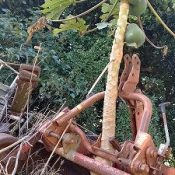
February 9, 2021 Ryukyu Shimpo
By Mitsue Chinen
Ie – In Nishieue, Ie, a single papaya tree grows in front of a farmer’s shed. The roots are twisted and the trunk has forced its way through the gaps in a discarded piece of farm equipment, but this tree stubbornly continues to grow. This has earned the tree attention and the name “gutsy papaya.”
According to farmers in the area, the tree first put out buds last summer. Soon after, a typhoon hit the island. The strong winds battered and bent the tree. A gust of wind picked up a nearby net and deposited it over top of the tree. Even so, the tree didn’t wither, but continued growing.
However, even before that, a tractor rotary tiller was discarded there. This should have been the end, but the gutsy papaya forced its way through gaps in the machinery and still continued to grow. In spite of the many challenges the tree has faced, its branches are currently heavy with fruit.
Neighbors say, “the tree’s grit has allowed it to overcome adversity and gives us strength to carry on.”
(English translation by T&CT and Ellen Huntley)
Go to Japanese
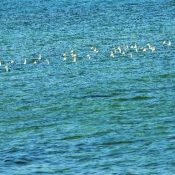
February 10, 2021 Ryuyu Shimpo
A flock of migratory birds was seen on January 31 over the ocean in front of San-A Urasoe Nishikaigan Parco City. According to Chairman Masakuni Yamashiro of the Wild Bird Society of Okinawa, these migratory birds appear to be Kentish plovers. Chobin Yara, 71, from Ginowan City, who photographed the birds, said that this “shows that the natural environment is abundant.”
The Kentish plover is a rare species, and is designated as an endangered species by the Ministry of the Environment, among other agencies. Around 8:30 a.m., Yara saw approximately 150 of the Kentish plovers flying over the ocean at high tide.
Yara said, about the Kentish plovers, “Although normally observed at the Awase tidal flats, a flock flying together is rarely seen. They flew over the ocean for just a moment, but if it were low tide we likely would have seen them catching food in the shallows.”
Chairman Yamashiro said, “This has been a difficult area of the ocean to access so it has not been known, but there is a coral reef peculiar to Okinawa here. It is a valuable environment where waterfowl gather.”
The whole area is planned for land reclamation as part of the relocation of the Naha Port Facility (Naha Military Port).
(English translation by T&CT and Erin Jones)
Go to Japanese
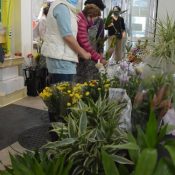
February 12, 2021 Ryukyu Shimpo
This year, the first day of the Lunar Calendar falls on February 12. The day before, on tushinuyuru (Lunar New Year’s Eve), the Itomaru public market in Itoman City was bustling with customers purchasing pork, fish cakes, and cut flowers for the celebration.
The market was renovated last year, and this is the first Lunar New Year for Itomaru.
Kazuko Oshiro, 71, the second-generation owner of the butcher shop Oshiro Seinikuten said, “I expected fewer customers because of COVID-19, but there’s been a steady stream of people for several days, and we’ve been busy. We even ran out of pork tripe. I’m glad it’s so lively.”
An 85-year-old woman at a rest area located inside the market said, “I’m going to cook sekihan (red rice) to offer [the ancestors] at the family altar.” She smiled and said, “Preparing for it is a lot of work, but New Year’s Eve is fun.”
(English translation by T&CT and Monica Shingaki)
Go to Japanese
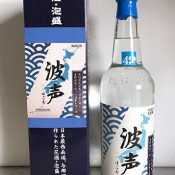
February 5, 2021 Ryukyu Shimpo
By Yuki Muramatsu
Yonaguni – Sakimoto Distillery (Toshio Sakimoto, CEO) in Yonaguni announced to Yonaguni Mayor Shukichi Hokama at the town hall January 20 the creation of a new awamori named “Hagoe” (43% alcohol by volume (ABV), 600 ml bottle). The name “Hagoe” was chosen by combining the imagery of the rough island waves (‘ha’) with the idea of song sung by herring fishermen on their boats in the town of Rebun, Hokkaido (‘koe’).
An organization in Rebun, the “Island pride creation project,” (Yuji Yanagiya, representative) has commissioned the distillery for brewing. Hagoe is made using hanazake (a strong awamori at 60% ABV) distilled using spring water shipped directly from Rebun.
The distant island of Rebun (Toru Ono, mayor), at Japan’s northern end, is a single island municipality, the same as Yonaguni far to the south. In November of 2019, the two towns forged an agreement of friendship and cultural exchange.
Prior to releasing the liquor for sale, bottles were distributed to retailers and bars throughout Rebun. So far, it has received praise from those who have tasted it, with some saying it has a “clean and refreshing taste.”
On January 20, Mayor Hokama was informed about the completion of Hagoe, as well as the story of how it came into existence. There were also statements made from representatives within Yonaguni such as, “Since Rebun put so much effort into this, Yonaguni wants to help with things such as the shipping costs for the water.” Sakimoto said that for further development of the liquor, “We are thinking of further lowering the ABV, to produce a milder and less expensive variant. Rebun also produces konbu, and since there is liquor that can be made with konbu, I want to make a konbu shochu with their konbu as a source ingredient.”
Made with cooperation by and hoping for the prosperity of both islands, Hagoe awamori made with spring water from Rebun is on sale starting February 5 in Yonaguni, Rebun, and at “Washita Shop” in Sapporo.
(English translation by T&CT and Sam Grieb)
Go to Japanese
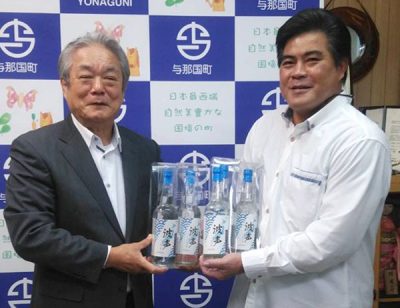
Yonaguni Mayor Shukichi Hokama (left) being handed Hagoe awamori by Sakimoto Distillery CEO Toshio Sakimoto – January 20, at Yonaguni Town Hall

February 6, 2021 Ryukyu Shimpo
On February 4, the food ordering and delivery platform Uber Eats announced it will expand its service to parts of Okinawa City and Uruma City beginning February 18.
The platform has partnered with approximately 45 restaurants in the two cities. Customers may order a variety of foods for delivery, including Japanese cuisine, ethnic cuisines, and standard menu items such as hamburgers and curry. Delivery services will be available between 9 a.m. and midnight but will vary depending on the restaurant.
Uber Eats first launched its services in Okinawa Prefecture last August and currently serves the northern part of Naha’s city center and the southern part of Urasoe City. The expansion brings the total service area to four cities.
Deliveries to Okinawa City and Uruma City are only available from restaurants within the same area. A spokesperson for Uber Eats said, “We are enthusiastic about further expanding the delivery area [in Okinawa].”
(English translation by T&CT and Monica Shingaki)
Go to Japanese












 Webcam(Kokusai Street)
Webcam(Kokusai Street)


